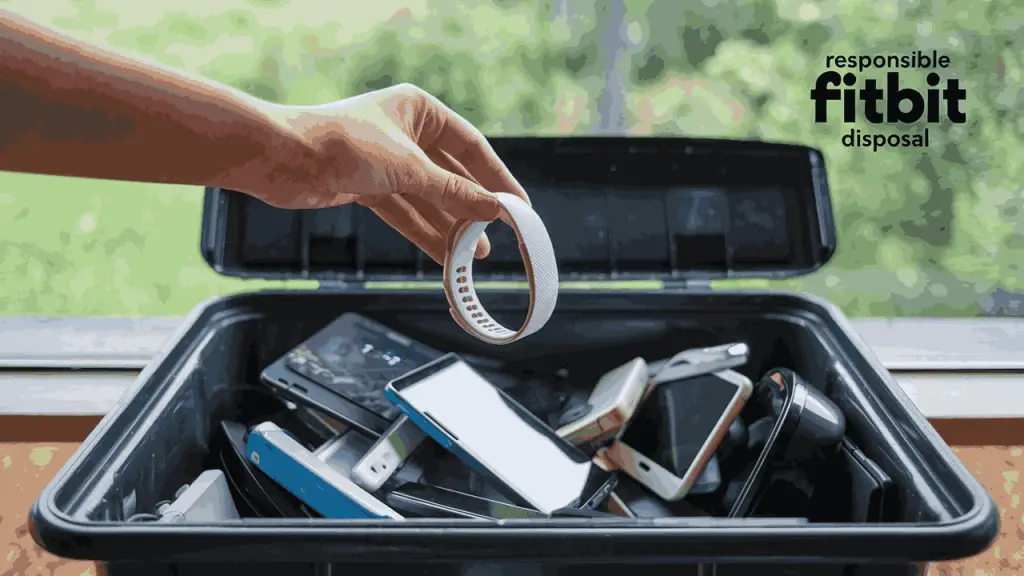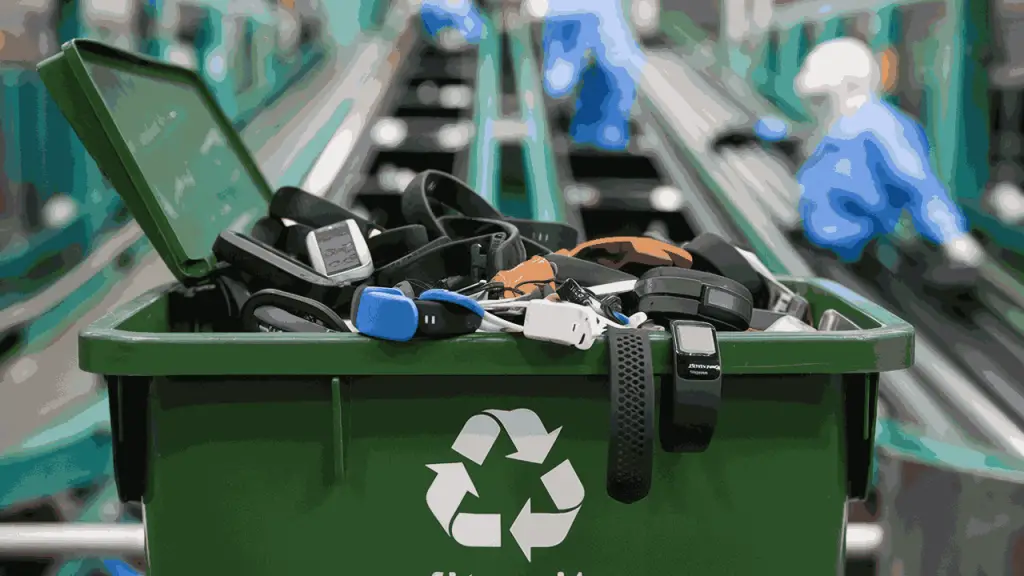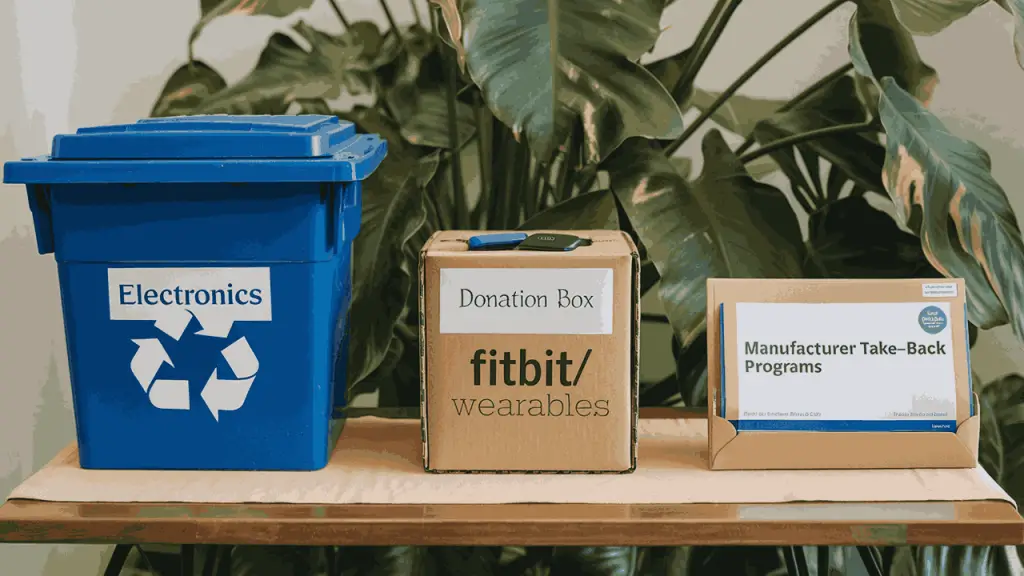As technology advances, responsibly disposing of outdated fitness trackers becomes essential. Fitbits contain hazardous materials like lead, mercury, cadmium that can harm the environment and public health if discarded improperly.
This guide provides a clear, concise roadmap to prepare your device, explore disposal options, and understand the benefits of responsible e-waste management.♻️

Why Proper Fitbit Disposal Matters
Improper disposal of your Fitbit contributes to the global e-waste crisis, one of the fastest-growing waste streams.
Toxic substances like lead, mercury, and cadmium can leach into soil and water, polluting ecosystems and posing health risks to communities. Responsible disposal reduces these threats, protecting both the planet and people.
Preparing Your Fitbit for Disposal
Now that we’ve covered why proper Fitbit disposal matters, let’s prepare your device for safe disposal. Here’s what you need to do:
A. Erasing personal data
Before disposing of your Fitbit, it’s crucial to remove all your personal information. Access your device settings and follow the specific instructions for your model to erase all data, including apps and payment details. Remember to remove Suica separately via the app if applicable.
B. Performing a factory reset
| Reset Type | Description | When to Use |
| Soft Reset | Simple restart, retains data | First troubleshooting step |
| Factory Reset | Erases all data, restores to default | Last resort, before disposal |
C. Removing the battery (if possible)
With your data erased and device reset, consider removing the battery if your Fitbit model allows it. (Note: This may void the warranty.)
These steps apply no matter how you choose to dispose of your Fitbit, ensuring it’s ready for its next step.
Fitbit Recycling Options

Now that you’ve prepared your Fitbit for disposal by erasing your personal data, choose from these recycling methods once your device is prepped:
A. Fitbit’s free recycling program
Fitbit offers a convenient and environmentally responsible way to dispose of your device through their free recycling program. Here’s how you can take advantage of this option:
- Visit the Fitbit website
- Request a free shipping label from their third-party recycling partner
- Pack your device securely
- Follow the provided shipping instructions or drop it off at a designated collection site
This program ensures that your Fitbit is recycled properly, minimizing its environmental impact.
B. Retailer recycling programs (e.g., Best Buy)
Many retailers, such as Best Buy, have their own electronics recycling programs. These can be an excellent option if you prefer a more immediate solution. Some benefits include:
- Convenience of dropping off your device at a local store
- Potential rewards, such as gift cards, for recycling your Fitbit
- Assurance that your device will be handled responsibly
C. Local electronic waste facilities
Your community may have dedicated e-waste recycling centers that accept Fitbit devices. These facilities specialize in properly disposing of electronic devices and their components. To find a local e-waste facility:
- Check your city or county’s waste management website
- Look for designated drop-off locations or collection events
- Ensure the facility accepts wearable technology devices
Examples of such facilities include:
- In the UK: Recycle Your Electricals – 26,600+ drop-off points for Fitbits
- In Canada: City of Toronto E-Waste – recycling program for Fitbits
- Also in Canada: ERA Canada – accepts Fitbits at depots nationwide
D. U.S. Postal Service recycling options
The U.S. Postal Service offers an additional avenue for recycling your Fitbit. This option can be particularly useful if you don’t have easy access to other recycling methods. Here’s a comparison of USPS recycling with other options:
| Feature | USPS Recycling | Fitbit Program | Retailer Programs | Local Facilities |
| Cost | May have fees | Free | Often free | Usually free |
| Convenience | Mail from home | Mail from home | In-store drop-off | Local drop-off |
| Availability | Nationwide | Nationwide | Varies by retailer | Varies by location |
| Rewards | No | No | Possible gift cards | Typically no |
Next, we’ll explore alternative disposal methods for those who may not have access to these recycling programs or prefer different approaches to managing their old devices.
Alternative Disposal Methods

A. Selling functional parts
If your Fitbit is still partially functional, you might consider selling its working components. Many online platforms, such as eBay, allow you to sell electronic parts.
This not only helps you recoup some of the device’s value but also contributes to the circular economy by extending the life of usable components.
| Platform | Benefits |
| eBay | Wide audience, easy to use |
| Decluttr | Specializes in electronics |
| Local marketplaces | Avoid shipping costs |
B. Donating to charities or organizations
Your old Fitbit could find a new purpose through donation. Many organizations accept used electronics for various causes:
- Schools for educational purposes. You can donate through platforms like DonorsChoose, where teachers request Fitbits for classroom projects.
- To charities that refurbish devices for those in need. RecycleHealth takes used Fitbits/ activity trackers/smart watches to help underserved populations improve their health.
- To research institutions studying wearable technology such as University of Minnesota’s Wearable Technology Lab, Imperial College London’s Wearable Technologies Lab, University of St. Andrews’ Human Interaction Group.
Benefits of Responsible Fitbit Disposal
Now that we’ve covered the alternative disposal methods, let’s explore the benefits of responsible disposal. You’ll find that proper disposal not only protects you but also contributes to a better world.
A. Protecting personal information
By responsibly disposing, you safeguard your personal data. Performing a factory reset before recycling ensures your information doesn’t fall into the wrong hands.
B. Contributing to environmental sustainability
Proper Fitbit disposal helps conserve resources and reduce pollution. Here’s how:
| Environmental Benefit | Impact |
| Reduces e-waste | Prevents toxic materials from leaching into soil and water |
| Conserves resources | Recycling metals and plastics reduces need for new extraction |
| Lowers emissions | Decreases greenhouse gases associated with e-waste in landfills |
C. Supporting charitable causes through donations
By donating your old Fitbit to organizations that refurbish devices for those in need, supporting both social causes and sustainability efforts.
Conclusion
Taking the time to dispose of your Fitbit the right way matters for the planet and for keeping your personal stuff safe. Before you say goodbye to it, make sure to wipe your data and do a full reset.
You’ve got options like Fitbit’s free recycling program, or you can drop it off at electronics stores, local recycling spots, or places that handle e-waste properly. When you do this, you’re helping save resources, cut down on junk piling up, and keep our environment in good shape.
Plus, you’re locking down your info so it doesn’t end up in the wrong hands. Thus, every little step you take helps tackle the e-waste problem! And if you’ve got other devices, like a watch, that need to go, check out our guide on How To Dispose of A Watch for more handy tips.

